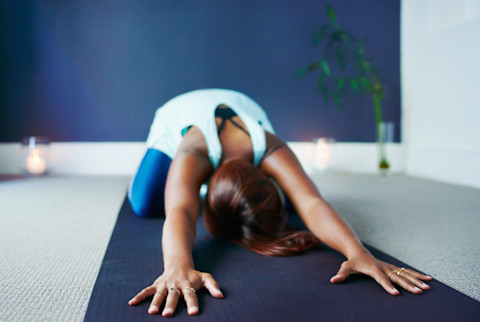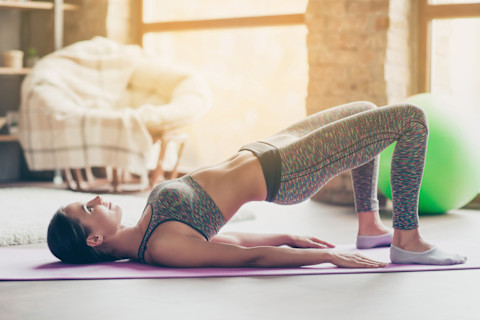
There's a lot of talk from teachers and experts about why not to do yoga during your period. I'm here to say, do it! Practicing certain postures during your time of the month can aid in relief from the aches and pains that can go along with your menstrual cycle.
It all starts with cramps, but what exactly are they? Cramps, or period pains, happen when the muscles in the female's uterus contract. This breaks down the uterus lining, passing it out of your body as a period. Fortunately, the cramps come from muscles, which can be alleviated through postures focusing on your lower abdomen and pelvis.
All that to say, when the going gets tough—typically around the beginning of a cycle before menstruation and lasting a day or two—these five poses are wonderful to add to your practice:
Seated twist
Accompanied by your breathing, this posture works both the abdomen and areas of the pelvis by compressing and cleansing the muscle areas.
Start in a seated position with both legs extended in front of you. Bend your right knee, placing the foot adjacent to your left knee. Lift your left arm up on the inhale, twisting toward your right looking over your shoulder. As you do so, hook your elbow over your knee for a self-assist. Move into the twist gently with each of your exhales, breathing for at least five breaths. Switch sides.
Bridge pose

This gentle press of the belly on your "bridge" of the hips upward can comfortably compress the muscles of the entire abdomen and pelvis region.
From your back, bend both knees, placing your feet on the floor and your hands almost touching the back of your heels. With the back of your head and shoulders comfortably level to the floor, inhale and press into your feet, lifting the hips away from the mat. You can remain here, in a low bridge, or continue to elevate the hips higher on each inhale, pressing the shoulders and forearms in toward the floor for support. Lower back down after five to 10 breaths.
Seated bound-angle pose
Working the inner muscles of the pelvis and inner hips, feel free to add in props (such as a block under your knees, under your forehead, or variations using a blanket) for a more restorative approach.
From a seat, bring the soles of your feet together with your knees dropped out to the side, and press your thumbs into the inner arches of your feet. Extend your spine long on your inhale, lengthening your chest and chin forward. On the exhale, imagine bringing your belly button closer to touch your feet. Repeat this cycle five or so times, syncing with your breathing, continuing to keep your spine extended the entire time.
Double-legged forward fold
This gentle press of the thighs on your sore belly can give a sense of going inward, which is soothing for both your body and your mind. If you have tighter hamstrings, feel free to use a strap or large towel to wrap around the soles of your feet to aid in the extension to fold forward.
From a seat, extend both of your legs in front of you. Feel free to bend your knees in this one, especially if you are not super flexible in the hamstrings or not already warmed up. Using the strap, or having knees bent, on your inhale extend your chest forward toward your feet (as suggested in the previous posture). Keeping the spine long and not rounded, move in to the fold with each exhale when space allows. It's important to continue deep breathing on this one, so make those inhales and exhales long and deep for maximum pain relief.
Child's pose
When all else fails, child's pose it. That's good advice for life and for periods.
From a kneeling position, place your chest on your thighs, arms extended out in front of you. In this version, I recommend you have your chest on your thighs instead of legs wide for the benefit of gentle compression on your abdomen muscles on your own legs. Feeling your breathing and hearing the sound of your breath can be incredibly nurturing and healing at the same time as providing physical relief.
